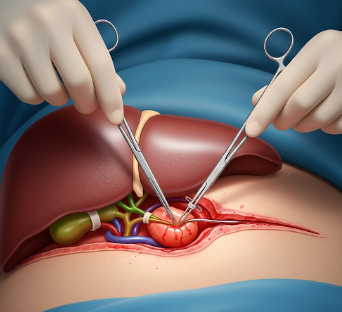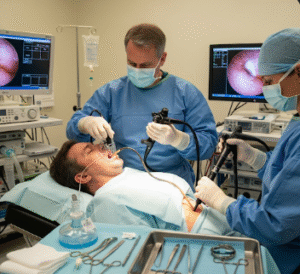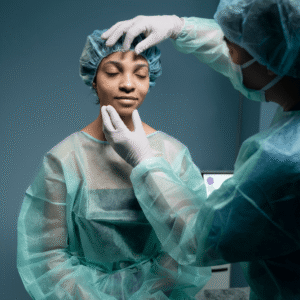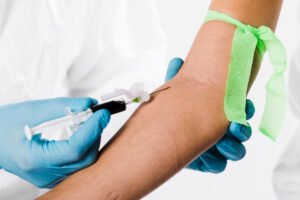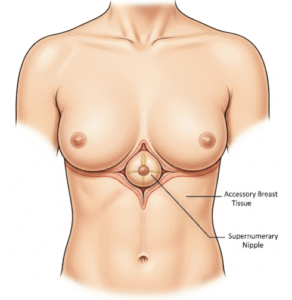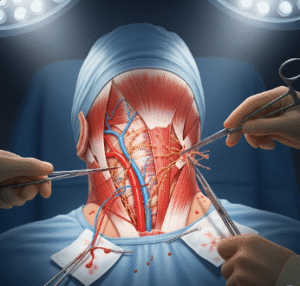Overview
Open cholecystectomy is a surgical procedure to remove the gallbladder through a larger abdominal incision. It is usually performed when laparoscopic (minimally invasive) removal is not feasible, such as in cases of severe inflammation, scar tissue, or complicated gallstone disease.
South Korea offers state-of-the-art surgical care for open cholecystectomy in specialized hepatobiliary and general surgery centers, ensuring high surgical precision, advanced post-operative care, and rapid recovery.
What is Open Cholecystectomy?
Open cholecystectomy involves making an incision in the upper right abdomen to access and remove the gallbladder. Conditions commonly treated include:
✔ Gallstones (cholelithiasis) causing pain or obstruction
➔ Cholecystitis: Acute or chronic inflammation of the gallbladder
● Gallbladder polyps or tumors
★ Complicated biliary tract disease or previous abdominal surgery preventing laparoscopic removal
Open cholecystectomy is generally performed when laparoscopic surgery is risky or impossible due to adhesions, infection, or anatomy.
What are the Benefits?
Open cholecystectomy provides definitive treatment for gallbladder disease:
✔ Complete removal of diseased gallbladder
➔ Relieves pain and prevents recurrent attacks
● Prevents complications such as infection, perforation, or bile duct injury
★ Allows direct visualization of surrounding structures for safer surgery
➤ Can be performed in complicated cases where laparoscopy is not safe
Procedure Details
1) How should I prepare for Open Cholecystectomy?
Preparation helps reduce risks and ensure smooth recovery:
✔ Medical evaluation: Blood tests, liver function tests, ultrasound, or CT scan.
➔ Medication review: Blood thinners may need to be paused.
● Fasting: Typically 6–8 hours before surgery.
★ Patient counseling: Surgeons explain procedure, risks, recovery, and dietary modifications post-surgery.
➤ Lifestyle adjustments: Stop smoking, maintain hydration, and manage chronic conditions.
2) What happens during the procedure Open Cholecystectomy?
Open cholecystectomy is performed under general anesthesia and typically lasts 1–2 hours:
✔ Incision: Right upper abdominal incision (usually subcostal).
➔ Gallbladder exposure: Liver lifted to access the gallbladder.
● Gallbladder removal: Dissection from the liver bed and ligation of cystic duct and artery.
★ Inspection: Surrounding bile ducts and liver inspected to prevent injury.
➤ Closure: Incision sutured in layers; sterile dressing applied.
In South Korea, surgeons may combine laparoscopic assessment and open conversion to minimize incision size when possible.
3) What happens after Open Cholecystectomy?
Postoperative care focuses on pain control, wound healing, and return to normal function:
✔ Hospital stay: Typically 3–5 days depending on recovery.
➔ Pain management: Analgesics to control post-surgical pain.
● Activity: Gradual mobilization recommended; avoid heavy lifting for 4–6 weeks.
★ Dietary modifications: Low-fat diet initially to allow digestive adaptation.
➤ Follow-up: Wound checks, liver function tests, and monitoring for complications.
Risks / Benefits
Possible Risks:
✔ Infection at incision site
➔ Bleeding or hematoma
● Injury to bile ducts or surrounding organs
★ Hernia formation at the incision site
➤ Postoperative digestive changes (diarrhea, bloating)
Major Benefits:
✔ Definitive treatment for gallbladder disease
➔ Relieves pain and prevents recurrent attacks
● Reduces risk of complications like infection or perforation
★ Direct visualization ensures safety in complicated cases
➤ Minimally invasive options not possible? Open surgery is reliable and effective
Recovery and Outlook
✔ Initial recovery: 1–2 weeks for incision healing; full recovery 4–6 weeks.
➔ Physical activity: Gradual return to normal activities; avoid heavy lifting.
● Diet: Low-fat diet initially; regular diet resumed gradually.
★ Long-term outcome: Most patients remain symptom-free and enjoy improved quality of life.
➤ Follow-up: Routine surgical follow-ups to monitor healing and liver function.
When To Call the Doctor
Patients should contact their doctor if they notice:
✔ Severe abdominal pain or tenderness
➔ Fever, redness, or discharge at incision site
● Jaundice (yellowing of skin/eyes)
★ Persistent nausea, vomiting, or inability to eat
➤ Swelling or bulging near incision (possible hernia)
Best Korea Option / Process
South Korea offers world-class open cholecystectomy care with:
✔ Leading hospitals: Asan Medical Center, Samsung Medical Center, Seoul National University Hospital.
➔ Advanced surgical techniques: Open and laparoscopic hybrid approaches.
● Experienced surgical teams: Hepatobiliary and general surgeons with extensive experience.
★ Comprehensive post-op care: Pain management, diet counseling, and rehabilitation.
➤ Medical tourism support: Translation, travel arrangements, and post-surgery follow-up for international patients.
✅ Highlights:
✔ Open cholecystectomy removes the gallbladder via abdominal incision
➔ Used when laparoscopic surgery is not safe or feasible
● Treats gallstones, cholecystitis, or biliary tumors
★ Risks include infection, bile duct injury, bleeding, or hernia
➤ Korean hospitals provide advanced surgical care, safety, and comprehensive recovery support

